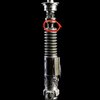WOW! Switching to second shift hasn’t left me a lot of time to stay up to date on everything! But after reading all of this (and some what processing it) Between Halliwax’s demonstration, and Dave’s organized explanations, I believe all of this makes sense so far…. I’ve always been on board with the break-neck theory. I’m currently a machinist, and I machine foundry cast brass parts. It is NOT uncommon to see parts break in weaker areas, and have to be revised by engineers. It is obvious that the neck groove would be the weakest point, and castings, (metal or not) as shown in Danny’s demonstration, CAN break like ice just by dropping them on the ground…So to assume the necks broke this way, (especially in such a thin area of rather porous aluminum) and that they assumed their initial more solid form in ANH (as more of a unibody design) is not a jump by any stretch of the imagination. I believe most of all, Dave has made it clear with his compiled research he’s been willing to (and has) changed his mind multiple times in this design, to arrive at an internally and externally accurate prop, as close to what we see on screen as possible. Thanks for all of this Dave! Happy to be apart of this run, and even more happy to see all of this research laid out !
!
-Ariston
-Ariston

